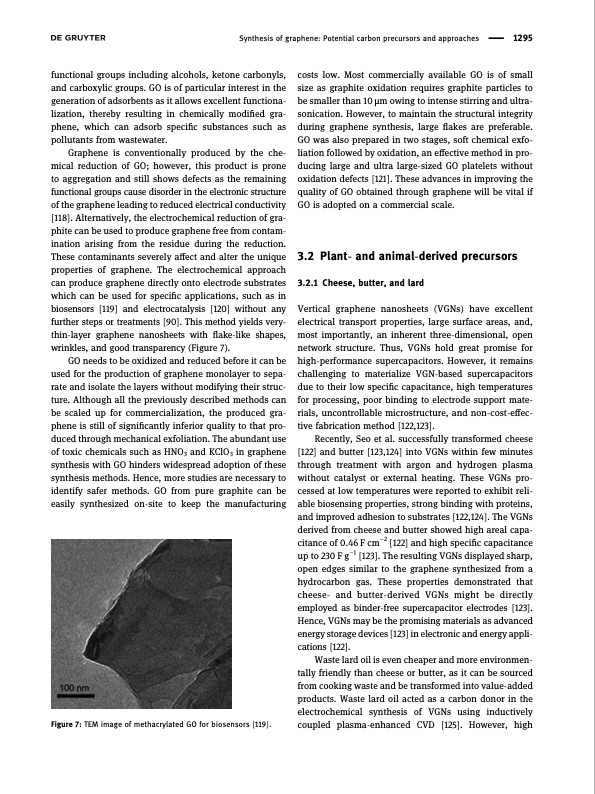PDF Publication Title:
Text from PDF Page: 012
functional groups including alcohols, ketone carbonyls, and carboxylic groups. GO is of particular interest in the generation of adsorbents as it allows excellent functiona- lization, thereby resulting in chemically modified gra- phene, which can adsorb specific substances such as pollutants from wastewater. Graphene is conventionally produced by the che- mical reduction of GO; however, this product is prone to aggregation and still shows defects as the remaining functional groups cause disorder in the electronic structure of the graphene leading to reduced electrical conductivity [118]. Alternatively, the electrochemical reduction of gra- phite can be used to produce graphene free from contam- ination arising from the residue during the reduction. These contaminants severely affect and alter the unique properties of graphene. The electrochemical approach can produce graphene directly onto electrode substrates which can be used for specific applications, such as in biosensors [119] and electrocatalysis [120] without any further steps or treatments [90]. This method yields very- thin-layer graphene nanosheets with flake-like shapes, wrinkles, and good transparency (Figure 7). GO needs to be oxidized and reduced before it can be used for the production of graphene monolayer to sepa- rate and isolate the layers without modifying their struc- ture. Although all the previously described methods can be scaled up for commercialization, the produced gra- phene is still of significantly inferior quality to that pro- duced through mechanical exfoliation. The abundant use of toxic chemicals such as HNO3 and KClO3 in graphene synthesis with GO hinders widespread adoption of these synthesis methods. Hence, more studies are necessary to identify safer methods. GO from pure graphite can be easily synthesized on-site to keep the manufacturing Figure 7: TEM image of methacrylated GO for biosensors [119]. costs low. Most commercially available GO is of small size as graphite oxidation requires graphite particles to be smaller than 10 μm owing to intense stirring and ultra- sonication. However, to maintain the structural integrity during graphene synthesis, large flakes are preferable. GO was also prepared in two stages, soft chemical exfo- liation followed by oxidation, an effective method in pro- ducing large and ultra large-sized GO platelets without oxidation defects [121]. These advances in improving the quality of GO obtained through graphene will be vital if GO is adopted on a commercial scale. 3.2 Plant- and animal-derived precursors 3.2.1 Cheese, butter, and lard Vertical graphene nanosheets (VGNs) have excellent electrical transport properties, large surface areas, and, most importantly, an inherent three-dimensional, open network structure. Thus, VGNs hold great promise for high-performance supercapacitors. However, it remains challenging to materialize VGN-based supercapacitors due to their low specific capacitance, high temperatures for processing, poor binding to electrode support mate- rials, uncontrollable microstructure, and non-cost-effec- tive fabrication method [122,123]. Recently, Seo et al. successfully transformed cheese [122] and butter [123,124] into VGNs within few minutes through treatment with argon and hydrogen plasma without catalyst or external heating. These VGNs pro- cessed at low temperatures were reported to exhibit reli- able biosensing properties, strong binding with proteins, and improved adhesion to substrates [122,124]. The VGNs derived from cheese and butter showed high areal capa- citance of 0.46 F cm−2 [122] and high specific capacitance up to 230 F g−1 [123]. The resulting VGNs displayed sharp, open edges similar to the graphene synthesized from a hydrocarbon gas. These properties demonstrated that cheese- and butter-derived VGNs might be directly employed as binder-free supercapacitor electrodes [123]. Hence, VGNs may be the promising materials as advanced energy storage devices [123] in electronic and energy appli- cations [122]. Waste lard oil is even cheaper and more environmen- tally friendly than cheese or butter, as it can be sourced from cooking waste and be transformed into value-added products. Waste lard oil acted as a carbon donor in the electrochemical synthesis of VGNs using inductively coupled plasma-enhanced CVD [125]. However, high Synthesis of graphene: Potential carbon precursors and approaches 1295PDF Image | Synthesis of graphene Potential carbon precursors

PDF Search Title:
Synthesis of graphene Potential carbon precursorsOriginal File Name Searched:
10-1515-ntrev-2020-0100.pdfDIY PDF Search: Google It | Yahoo | Bing
Salgenx Redox Flow Battery Technology: Power up your energy storage game with Salgenx Salt Water Battery. With its advanced technology, the flow battery provides reliable, scalable, and sustainable energy storage for utility-scale projects. Upgrade to a Salgenx flow battery today and take control of your energy future.
CONTACT TEL: 608-238-6001 Email: greg@infinityturbine.com (Standard Web Page)